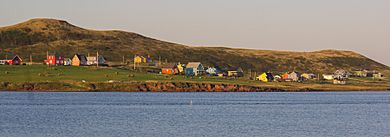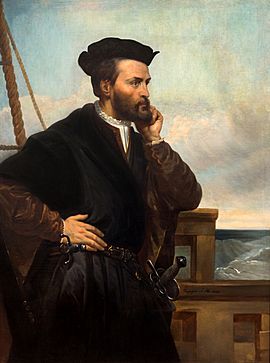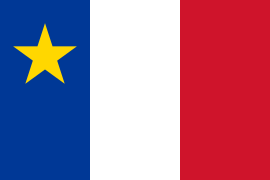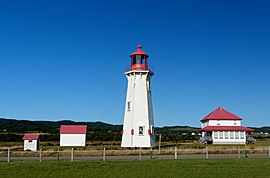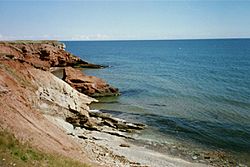Magdalen Islands facts for kids
|
Native name:
Îles de la Madeleine
|
|
|---|---|
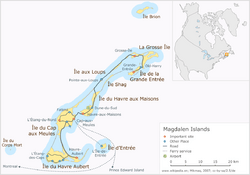
The Magdalen Islands
|
|
| Geography | |
| Location | Gulf of Saint Lawrence |
| Coordinates | 47°26′54″N 61°45′08″W / 47.44833°N 61.75222°W |
| Area | 205.53 km2 (79.36 sq mi) |
| Administration | |
|
Canada
|
|
| Province | Quebec |
| Demographics | |
| Population | 12,781 (2011) |
| Pop. density | 62.2 /km2 (161.1 /sq mi) |
| Additional information | |
| Time zone | |
| • Summer (DST) | |
| Area code(s) | 418 and 581 |
The Magdalen Islands (French: Îles de la Madeleine) are a small archipelago in the Gulf of Saint Lawrence with a land area of 205.53 square kilometres (79.36 sq mi). While part of the Province of Quebec, the islands are in fact are closer to the Maritime provinces than to the Gaspé Peninsula on the Quebec mainland.
Administratively, the islands are part of the Gaspésie–Îles-de-la-Madeleine region in the Canadian province of Quebec, The islands form the territory equivalent to a regional county municipality (TE) and the census division (CD) of Les Îles-de-la-Madeleine. Their geographical code is 01.
The islands are also coextensive with the Urban agglomeration of Les Îles-de-la-Madeleine, which is divided into two municipalities: Les Îles-de-la-Madeleine (2011 census pop. 12,291), the central municipality, and Grosse-Île (pop. 490). Their mayors are Jonathan Lapierre and Rose Elmonde Clarke, respectively.
Contents
Geography
There are eight major islands: Amherst, Grande Entrée, Grindstone, Grosse-Île, House Harbour, Pointe-Aux-Loups, Entry Island, and Brion, all except Brion being inhabited. There are several other tiny islands that are also considered to be part of the archipelago: Bird Rock (Rocher aux Oiseaux), Seal Island (Île aux Loups-marins), Île Paquet, and Rocher du Corps Mort.
The interiors of the islands were once completely covered with pine forests. An ancient salt dome underlies the archipelago. The salt's inherent buoyancy forces the uplift of the overlying Permian red sandstone.
Nearby salt domes are believed to be sources of fossil fuels. Rock salt is mined on the Islands.
Erosion
Several news articles in 2019 pointed out that erosion of the coastline had already become a significant issue. Researchers have found that the amount has doubled since 2005, and was averaging half a meter (20") per year. Recent events that added to the problem included a significant windstorm in November 2018 and the post-tropical storm Dorian that hit the islands in September 2019.
A Washington Post report in late October 2019 also indicated that increasing temperatures have led to reduced ice cover over the years, leading to less protection from winter storms. "That ice has been disappearing ... [and the] sea-level rise, have caused the islands to crumble into the sea".
Researchers have found that the rise in sea levels has been approximately double that of the global norm and that the sea ice is shrinking at approximately 12% per decade. A November 2019 Washington Post report provided these specifics about the effects of erosion:
"Some parts of the shoreline have lost as much as 14 feet per year to the sea over the past decade. Key roads face perpetual risk of washing out. The hospital and the city hall sit alarmingly close to deteriorating cliffs. Rising waters threaten to contaminate aquifers used for drinking water ... Nearly a dozen homes on the islands have been relocated, and most everyone expects that number to grow."
The sole benefit has been the increase in lobster yields on the islands, at least double what was the norm in the past.
History
In 1534, the explorer Jacques Cartier was the first known European to visit the islands. However, Mi'kmaqs had been visiting the islands for hundreds of years, as part of a seasonal subsistence migration, probably to harvest the abundant walrus population. A number of archaeological sites have been excavated on the archipelago.
The archipelago was named in 1663 by François Doublet (1619 or 1620 - approx. 1678), the seigneur of the island, after his wife, Madeleine Fontaine.
In 1765, the islands were inhabited by 22 French-speaking Acadians and their families. They were working and hunting walruses for a British trader, Richard Gridley. Many inhabitants of the Magdalen Islands (Madelinots) still fly the Acadian flag and identify as both Acadian and Québécois.
The islands were administered as part of the British Colony of Newfoundland from 1763 to 1774, when they became part of Quebec by the Quebec Act.
Some of the islanders are descendants of survivors of the more than 400 shipwrecks on the islands. Some of the historic houses were built from wood that was from the shipwrecks.
The islands have some of Quebec's oldest English-speaking settlements. Although most anglophones have long either assimilated with the francophone population or migrated elsewhere, English-speaking settlements are found at Old Harry, Grosse-Ile, and Entry Island.
The islands are known for a children's French camp. Activities include sand castle competitions and a night alone in the woods.
To improve the safety of ships, the government constructed lighthouses on the islands. They indicate navigable channels and have reduced the number of shipwrecks, but many old hulks are found on the beaches and under the waters.
Until the 20th century, the islands were completely isolated during the winter since the pack ice made the trip to the mainland impassable by boat. The islands had no means of communication with the mainland. An underwater cable was installed to enable communication by telegraph, but in winter 1910, the cable broke, and the islands were again isolated. Residents sent an urgent request for help to the mainland by writing letters and sealing them inside a molasses barrel, or puncheon, which they set adrift. It reached the shore on Cape Breton Island, where residents notified the government of the emergency. The government sent an icebreaker to bring aid.
Within a few years, the government constructed new wireless telegraph stations on the Magdalens to ensure that they had communications during the wintertime. The puncheon became famous as a symbol of survival, and every tourist shop sells replicas.
At one time, large walrus herds were found near the islands, but over-hunting had eliminated them by the late 18th century.
In the 21st century, the islands' beaches provide a habitat for the endangered piping plover and the roseate tern.
Demographics
Population
| Canada census – Les Îles-de-la-Madeleine, Quebec community profile | |||
|---|---|---|---|
| 2011 | 2006 | ||
| Population: | 12,781 (-2.4% from 2006) | 13,091 (+2.1% from 2001) | |
| Land area: | 205.40 km2 (79.31 sq mi) | 205.40 km2 (79.31 sq mi) | |
| Population density: | 62.2/km2 (161/sq mi) | 63.7/km2 (165/sq mi) | |
| Median age: | 48.1 (M: 47.9, F: 48.4) | 44.5 (M: 44.1, F: 44.9) | |
| Total private dwellings: | 6,153 | 5,838 | |
| Median household income: | $52,267 | $47,914 | |
| References: 2011 2006 earlier | |||
| Historical Census Data - Les Îles-de-la-Madeleine, Quebec | ||||||||||||||||||||||||||
|---|---|---|---|---|---|---|---|---|---|---|---|---|---|---|---|---|---|---|---|---|---|---|---|---|---|---|
|
|
|
||||||||||||||||||||||||
Language
| Canada Census Mother Tongue - Les Îles-de-la-Madeleine, Quebec | ||||||||||||||||||
|---|---|---|---|---|---|---|---|---|---|---|---|---|---|---|---|---|---|---|
| Census | Total |
|
|
|
|
|||||||||||||
| Year | Responses | Count | Trend | Pop % | Count | Trend | Pop % | Count | Trend | Pop % | Count | Trend | Pop % | |||||
|
|
|
11,900 | 94.00% | 695 | 5.49% | 40 | 0.32% | 25 | 0.20% | |||||||||
|
|
|
12,030 | 92.72% | 830 | 6.40% | 50 | 0.38% | 65 | 0.50% | |||||||||
|
|
|
11,800 | 93.84% | 710 | 5.65% | 25 | 0.20% | 40 | 0.32% | |||||||||
|
|
|
12,925 | n/a | 94.13% | 715 | n/a | 5.21% | 60 | n/a | 0.44% | 30 | n/a | 0.22% | |||||
Climate
The maritime climate of the Magdalen Islands is markedly different from that of the mainland. The huge water masses that circle the archipelago both temper the weather and create milder conditions in each season. On the islands, winter is mild, spring is cool, summer has a few heat waves, and fall is typically warm. The Magdalen Islands have the least annual frost in Quebec. The warm breezes of summer persist well into September and sometimes early October. However, under the Köppen climate classification its climate is humid continental (Dfb) because its winters average far below freezing by maritime standards. Seasonal lag is strong because of the freezing water and the time that it takes for the gulf to warm up again. Also, in winter, sea ice occasionally forms, impeding offshore communications and activities.
The highest temperature ever recorded was 31.1 °C (88 °F) on 31 July 1949. The lowest temperature ever recorded was −27.2 °C (−17 °F) on 14 February 1891.
The Magdalen Islands have warmed 2.3 degrees Celsius (4.1°F) since the late 19th century, twice the global average. As a result, the residents are facing a growing number of problems, as extreme climate change transforms the land and water around them. The sea ice that used to encase and protect the islands from most winter storms is shrinking at a rate of about 555 square miles annually. Parts of the shoreline have eroded into the sea at a rate as much as 14 feet per year over the decade of the 2010s. Important roads are at risk of washouts, and important infrastructure, including the hospital and city hall sit near deteriorating cliffs. Recently the sea has been rising at a rate of 7 mm per decade, threatening to contaminate freshwater aquifers.
| Climate data for Îles-de-la-Madeleine Airport, 1981–2010 normals, extremes 1890–present | |||||||||||||
|---|---|---|---|---|---|---|---|---|---|---|---|---|---|
| Month | Jan | Feb | Mar | Apr | May | Jun | Jul | Aug | Sep | Oct | Nov | Dec | Year |
| Record high °C (°F) | 12.3 (54.1) |
9.0 (48.2) |
12.0 (53.6) |
17.2 (63.0) |
25.0 (77.0) |
28.9 (84.0) |
31.1 (88.0) |
30.6 (87.1) |
28.3 (82.9) |
21.6 (70.9) |
16.7 (62.1) |
12.6 (54.7) |
31.1 (88.0) |
| Mean daily maximum °C (°F) | −3.1 (26.4) |
−4.3 (24.3) |
−1.0 (30.2) |
3.8 (38.8) |
10.5 (50.9) |
16.1 (61.0) |
20.4 (68.7) |
21.0 (69.8) |
16.8 (62.2) |
10.9 (51.6) |
5.2 (41.4) |
0.2 (32.4) |
8.0 (46.4) |
| Daily mean °C (°F) | −6.4 (20.5) |
−8.2 (17.2) |
−4.1 (24.6) |
1.2 (34.2) |
7.0 (44.6) |
12.5 (54.5) |
17.1 (62.8) |
17.8 (64.0) |
13.9 (57.0) |
8.2 (46.8) |
2.8 (37.0) |
−2.3 (27.9) |
5.0 (41.0) |
| Mean daily minimum °C (°F) | −9.7 (14.5) |
−12 (10) |
−7.1 (19.2) |
−1.5 (29.3) |
3.5 (38.3) |
8.9 (48.0) |
13.8 (56.8) |
14.6 (58.3) |
10.9 (51.6) |
5.6 (42.1) |
0.4 (32.7) |
−4.8 (23.4) |
1.9 (35.4) |
| Record low °C (°F) | −26.5 (−15.7) |
−27.2 (−17.0) |
−26.1 (−15.0) |
−12.9 (8.8) |
−6.1 (21.0) |
0.0 (32.0) |
1.8 (35.2) |
3.9 (39.0) |
−1.1 (30.0) |
−5.6 (21.9) |
−12.8 (9.0) |
−24.4 (−11.9) |
−27.2 (−17.0) |
| Average precipitation mm (inches) | 97.3 (3.83) |
74.3 (2.93) |
76.0 (2.99) |
73.7 (2.90) |
86.3 (3.40) |
76.3 (3.00) |
75.5 (2.97) |
84.7 (3.33) |
95.8 (3.77) |
94.1 (3.70) |
108.9 (4.29) |
94.3 (3.71) |
1,037.3 (40.84) |
| Average rainfall mm (inches) | 37.1 (1.46) |
27.4 (1.08) |
39.0 (1.54) |
56.7 (2.23) |
82.0 (3.23) |
76.3 (3.00) |
75.5 (2.97) |
84.2 (3.31) |
95.8 (3.77) |
93.3 (3.67) |
91.6 (3.61) |
43.6 (1.72) |
802.6 (31.60) |
| Average snowfall cm (inches) | 61.1 (24.1) |
47.5 (18.7) |
37.0 (14.6) |
17.0 (6.7) |
4.5 (1.8) |
0.0 (0.0) |
0.0 (0.0) |
0.0 (0.0) |
0.0 (0.0) |
0.7 (0.3) |
17.3 (6.8) |
51.7 (20.4) |
236.8 (93.2) |
| Average precipitation days (≥ 0.2 mm) | 22.2 | 16.6 | 16.8 | 14.0 | 14.5 | 12.4 | 13.1 | 12.5 | 13.1 | 17.4 | 19.1 | 21.4 | 193.1 |
| Average rainy days (≥ 0.2 mm) | 5.6 | 4.3 | 7.3 | 10.6 | 14.1 | 12.3 | 13.1 | 12.5 | 13.1 | 17.2 | 14.1 | 7.2 | 131.2 |
| Average snowy days (≥ 0.2 cm) | 20.2 | 14.4 | 12.3 | 6.1 | 0.95 | 0.0 | 0.0 | 0.0 | 0.0 | 0.61 | 7.8 | 17.9 | 80.2 |
| Source: Environment Canada | |||||||||||||
Tourism
Tourism is a major industry on the islands, which have many kilometres (miles) of white sand beaches and steadily-eroding sandstone cliffs. Also, they are a destination for bicycle camping, sea kayaking, windsurfing, and kitesurfing. During the winter months, beginning in mid-February, ecotourists visit to observe newborn and young harp seal pups on the pack ice in the Gulf of St. Lawrence, which surrounds the islands. However the ice cover has reduced recently and the observation "season" has been cancelled several times.
Industry
The island is home to Canadian Salt Company Seleine Mines, which produces road salt for use in Quebec, Atlantic Canada and the United States' eastern seaboard. Opened in 1982, the salt mine and plant is located in Grosse-Île and extracts salt from an underground mine 30 metres (98 ft) below Grande-Entrée Lagoon. It produces 1 million tons of salt, and employs 200 people.
Although fishing is a traditional occupation, lobster have become a more lucrative local business. It was once common for lobstermen to haul in 15,000 pounds during a nine-week season that begins each spring, but now it is not unusual to bring home twice that amount, or more. This may be due to climate change has warmed the surrounding waters to some extent, yielded increasing lobster harvests.
Transportation
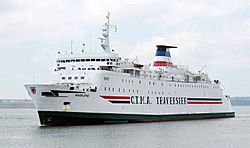
The Coopérative de transport maritime et aérien (Groupe C.T.M.A.) operates a ferry service between terminals in Souris, Prince Edward Island, and Cap-aux-Meules, on the islands. CTMA also operates a seasonal cruise ferry service between the islands and Montreal, which sits on a river island surrounded by mainland Quebec.
The Magdalen Islands Airport, at Havre-aux-Maisons, offers scheduled air service to the mainland of Quebec and, seasonally, to the French overseas collectivity of Saint-Pierre and Miquelon.
See also
 In Spanish: Islas de la Magdalena para niños
In Spanish: Islas de la Magdalena para niños


